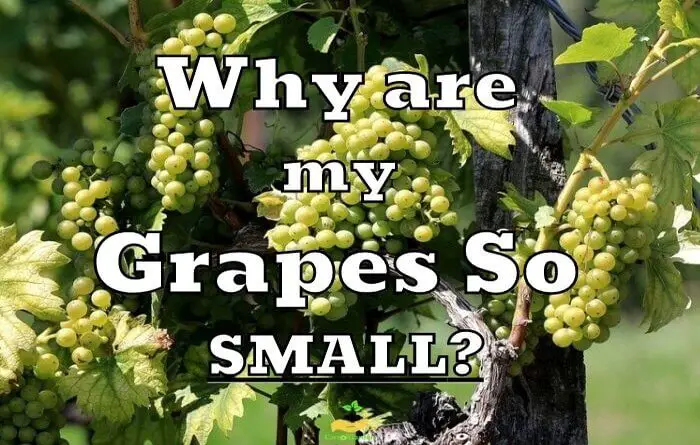Why Are My Grapes So Small? (Quick Answer Here)
You are so excited to start harvesting your grapes, but you notice that your grapes did not grow properly. Gardeners, faced with this problem, ask themselves: Why Are My Grapes So Small?
Let’s take a look at some reasons why this could happen and learn how to prevent small grapes on the vines.
| Why Are Grapes So Small: |
|---|
| 1. Lack of sunlight |
| 2. Insufficient Watering |
| 3. Lack of Nutrients |
| 4. Poor Pruning |
| 5. Pests |
| 6. Frost damage |
| 7.Young vines |
1. Lack of sunlight
The first reason why grapes are small and grow slowly is insufficient light. Because the grapevine is not receiving enough sunlight during the day time to produce fruit, it can’t make enough energy to grow big grapes.
If you live in a region where it gets too cold at night or if you live in a region where there isn’t enough sunlight during the day, grapes won’t grow well.
However, it is not possible without direct sunlight. If you want to grow big grapes yourself, you have to look for the warmest place on your property with plenty of midday and afternoon sun for the plants.
Grapevines grow best in full sun. They need seven or eight hours of direct sunlight each day. Less light leads to smaller grapes, poorer quality, increased powdery mildew and rot. Grapevines grow well on a wide range of soil types, but good drainage is very important.
It is best planted in front of a warm, protective house wall facing south-east or south-west. The soil should not be too calcareous and rather acidic.
How to treat Lack of sunlight
Grapes prefer sunny areas, so planting them in the shade is strictly prohibited. The best place for planting is on the the south side of the plot. It also needs plenty of light and space, and does not tolerate excessive growth.
If there is not enough sunlight, you must:
- Plant bushes on the sunny side, as grapes prefer light;
- Plant grapes near fences and small buildings, fences absorb heat, which the plant then absorbs;
- Avoid places with trees that can create shade;
- If the bush is large, the vine is thinned out, insulation is made from roofing felt around the root.
After the vine begins to receive a sufficient amount of light and heat, the growth of grape vine will quickly resume.
2. Insufficient Watering
The second reason why grapes do not grow is the lack of watering. Grapes remain small and not grow is that the soil around them is too dry. If the soil around them is too dry, then they cannot water themselves properly, which means they will stay small and not grow well.
If there is a lack of water during cell multiplication period (fruit set), the final size of the grape will decrease much more than at another time, due to the reduction in cell multiplication processes and in the future the capacity of the already created cells will increase.
The mode and rate of irrigation has a strong influence on the growth and yield of grapes. The ground around is mulched with humus, straw or sawdust to conserve moisture.
Young vines require about 1/2 to 1 inch of supplemental water per week, depending on rainfall, from June through September during the growing season.
How to treat Lack of water
So that the bushes do not freeze in growth and do not get sick with fungal diseases, the grapes are watered only with settled water that has warmed up in the sun. Watering with cold water is strictly prohibited, especially in the summer days.
When watering young vines, saturate the root zone with 5 gallons of water over a 3 x 3 foot area for 1 inch of water. Excess water can lead to root rot and fungal infections. After watering, the ground around the grapes must be loosened so that air can reach all parts of the plant’s root system.
3. Lack of Nutrients
The third reason why grapes remain small is because of a lack of nutrients in the soil. Nutrients are not taken up by the roots, so there is not enough strength for the normal development of the fruit.
Grapes growth, healthy blooming and fruit set are all directly influenced by the nutrients that are accessible to the plant. Conversely, a weak vine will have less carbon and nitrogen stored, leading to poor grape growth.
Nitrogen is the main element in plants responsible for their growth and development. When you add nitrogen to your grapevines, they will grow faster and produce bigger fruit. The lack of nitrogen is compensated by the deterioration of the quality of the vine and small grapes.
If you want big grapes that are also juicy, then you should add nitrogen to your soil before planting. You can do this by mixing in compost or manure when preparing the ground for your grapevines.
Nutrient Deficiency and Grape Response:
| Nutrient deficiency | What it does | Symptoms in Grapes |
|---|---|---|
| Iron | Allow photosynthesis in the grape vine and synthesize sugars. | Small size of the grapes. |
| Nitrogen | Increases the vigor and production capacity of the vines. | Slows grape growth, leaves turn pale. |
| Phosphorus | It has a fundamental role in fruiting. | The growth of grapes is slowed down. |
| Potassium | Increases the accumulation of sugars for the formation of the grape. | Reduces grape growth. |
| Boron | Ensures correct pollination and formation of full cluster of grapes. | Affect grape production with fewer canes. |
If nutritional deficiency is the cause of stunting, nutrients should not be applied thoughtlessly.
To avoid overfeeding the vines, observe the dosage. It is better to use a complex fertilizer containing all the vital elements – nitrogen, potassium, phosphorus.
It is advisable to apply these fertilizers in spring (end of April), during the flowering period, immediately after the end of flowering, and also during the period of active growth of grapes.
The most effective way to apply fertilizer is foliar top dressing, when the fertilizer falls directly on the leaf and is absorbed by the grapes as efficiently as possible.
The recommended dose is 40-50 grams of granular fertilizer per bush. The first dose should be applied in early spring, as soon as the snow has melted. The second fertilization is done a few weeks before flowering, the third at the beginning of the fruiting period.
4. Poor Pruning
The fourth reason why grapes remain small and do not grow is that they need to be pruned. If you don’t prune them, then the vine will just keep producing more and more grapes year after year, which can result in smaller grapes because there’s not enough sunlight for them to develop properly.
Pruning consists of removing wood from the branches of the plant so that new controlled shoots emerge, since only the buds at the ends of the branches, called vine shoots, receive sap .
Because on a lot of green shoots grow leaves, from which nutrients enter the grapes, and with a large overload, the growth stops, the leaves do not gain the necessary amount of nutrients and the grapes cannot gain their size, they remain small, about a pea.
Pruning grapevines helps them to grow strong and healthy. It also encourages the plant to produce more grapes than it would if left alone.
If you want to prune grapes in a way that will encourage them to produce big, juicy fruit, then you should prune your grapevines during the winter months.
This is because the plant is dormant at this time of year and does not need as much sun exposure as it does during the warmer months.
In autumn or late winter, the worn-out canes of the vines are cut back to one or two eyes. New shoots form from the eyes in spring.
Only leave the strongest fruit shoots, the others will be removed as long as they are not yet lignified. In summer you remove everything that shades the grapes. The tips of the long fruit shoots should be cut back in June.
How to prune grapes
You’ll only need a few tools to keep your grapes in shape for the next growing season, so make sure you only invest in the best on the market.
During the winter pruning, you must remove part of the side shoots on the trunk that have borne grapes during the summer. You need to cut back the side shoots so that only one to three buds remain. After pruning, the side shoots are called spurs.
Cut the worn buds back to one or two canes every year in autumn or late winter. New shoots form from the eyes in spring. You can either leave two or break out the weaker one in the spring.
More new shoots often appear on the buds , but these always have to be removed. Otherwise they would compete with grape shoots for water and nutrients.
If you have left two buds on the spur, there must be 20 cm between them on the stem. Some plants prefer long spore pruning, while other plants prefer short spore pruning. It is therefore important that you read up on which type is suitable for your plant.
5. Pests
Pests are another reason why grapes remain small and not grow is that some of them have been damaged during the harvest process (such as by birds) or by insects laying eggs in their clusters of grapes. This can result in a smaller grape than normal so that it doesn’t develop properly into a big grape!
Aphids
The most common pests of grapes are aphids , which can cause damage to the leaves, stems and fruit of the vine. If this happens to your grapevines, then they will be unable to produce food for themselves and as such grapes stay small and not grow well.
Aphids infect the root system and ground parts. At the same time, growth is disrupted and development is delayed. Yellow swelling and ulcers appear on the roots. With such manifestations, the plant cannot be saved.
There are many ways to remove aphids presented in this article!
Spider mites
Also infests grapevines in the home garden. Because these red spiders are less than a millimeter in size, they are difficult to spot with the naked eye. The symptoms that appear from the flowering period of the vine are unmistakable and clear:
- Bite marks on leaves
- Fine, light to brownish spots
- Shoot growth also decreases
- Grapes become smaller and paler
An old household remedy is the regular hosing down of the infested plant with water. It reduces spider mite infestation, but cannot always completely combat the pest.
6. Frost damage
If the weather is too wet or cold during flowering, grape development will slow down and the number and size of grapes may suffer. After flowering comes “fruit set” (the formation of the first bunches of green grapes), which corresponds to the beginning of ripening.
Stopping growth can be caused by frost on the shrub. The grapes can’t stand frost, at least not in most varieties. Poor or no insulation, extreme frost and mild winters, all of these factors can lead to frozen shrubs, their roots and fruits.
Young grapes do not tolerate low temperatures and winds. Therefore, it is necessary to cover the grapes with burlap. Also, in order to protect the plant from the cold wind, roofing material is used, from which fences are formed.
7. Young vines
The last reason why grapes remain small and do not grow is that they are too young. If the grapevine was planted when it was very young (i.e., less than three years old), then it won’t be able to produce big grapes until it’s at least five years old.
If you want your grapevines to grow well, then leave them for at least two years before harvesting any of the grapes from them.
How to Prevent Small Grapes
- For a rich harvest is the right location: grapes need a warm, full sun as well as frost and wind-protected place.
- The soil should not be too calcareous and rather acidic. Ideally, the pH of the soil is between 5 and 7.5 (slightly acidic to slightly alkaline).
- When it comes to watering the vine , it is better to do it little by little, at intervals, and always making sure not to add too much water, because the vine needs less humidity and more sun and heat.
- For any fertilization, strictly follow the instructions for using a particular product. An overdose, like a deficiency, also negatively affects the development of the grapes.
- When grapes begin to grow they must be protected from the bites of birds, wasps or any other insect that can harm them. To do this we can surround the fruits with brown paper leaving the bottom part open. Another option is to leave a few clusters free for birds to notice and leave the rest untouched.
- Pruning grape vines, or any fruit tree should be done every year to remove abandoned, non-productive vines and for new vines to take over. This encourages the production of high quality grapes, disease prevention and overall good health.
Conclusion
So, there are many reasons why grapes don’t growth and remain small. Some of this causes are quite simple to eliminate, while others require patience and responsibility from the your side.
I would like to add that in order for the vine to please with its fruits, seedlings must be purchased from trusted garden shops, from reliable suppliers.
Frequently Asked Questions
The size of many seedless table grape varieties can be substantially increased by applying Gibberellic Acid (GA3) two weeks after flowering. GA3 stimulates cell division and elongation, which increases the size of the grape.
The nutritional needs of growing grapes start with potassium (K), which will be key to increasing their size and giving them a better shape. Likewise, phosphorus (P) will perform the task of helping the internal transport of nutrients, which will also be key for a favorable fattening.
Newly planted vines have to be watered in spring and summer when it is dry. Older vines usually no longer need this because they have very deep roots and can therefore take care of themselves. In the first 3 years, it is best to use only organic fertilizers.
If the yield from the vines was very high in the previous year, the fruit set may be very low in the following year. This is also known from fruit growing.




